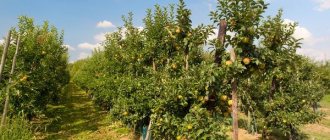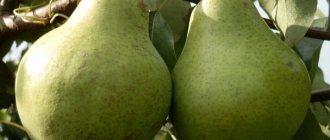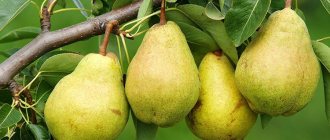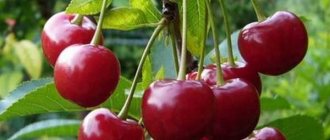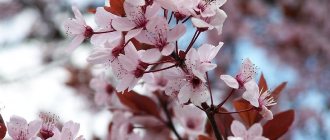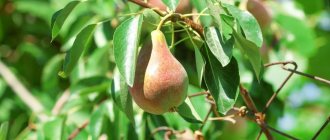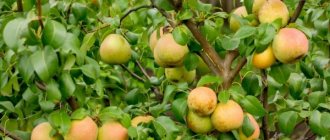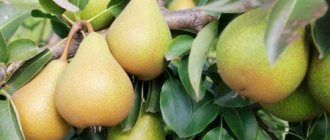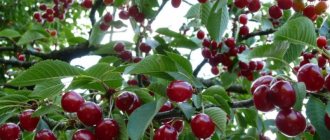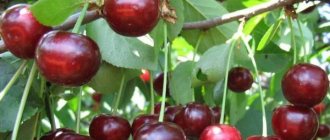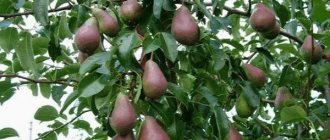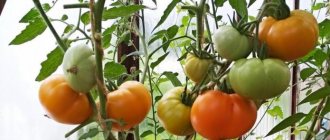Variety selection
The birth of Pyrus communis Starkrimson is due to American breeders (Michigan), who in 1939, with a free red mutation of the Lyubimitsa Klappa variety, acquired the Common Pear variety by cloning. Due to the passage of time, the resulting clone was given a sonorous, elegant name - Starkrimson. In 1956, the Stark brothers' gardening company Stark Brothers Nursery (Missouri) received a patent certificate for this variety, giving it a second name - Red Clapp's (red favorite). The name is due to the fact that the fruits of the bred beauty pear have a rich red color. Before you begin cultivating the selected fruit tree, you need to become familiar with its individuality, characteristics and biological differences.
Did you know? The pear tree is very durable, which is perhaps why the ancient Chinese considered it a symbol of immortality and called it Li.
Landing
For the healthy development of a pear, it is very important to correctly select and prepare a place for planting. By clicking on the links below, you can find a lot of useful information on the topic of planting the Starkrimson pear variety.
How to plant a pear tree correctly
At what distance to plant pears?
How to choose pear seedlings
How to replant a pear
Description of the tree
The height of adult specimens reaches 4-5 meters, so the plant belongs to the category of vigorous-growing. The large tree has a spreading pyramidal crown with dense green foliage. The leaves are narrowly lanceolate, short-pointed, 3–10 cm in size, dark green in color, and in some cases also cherry-colored. Flowering occurs in the mid-late period.
Did you know? Pear trees are long-lived plants. The lifespan of some specimens is 100–150 years, and fertility can last more than half a century.
Description of the variety "Starkrimson"
The pear of this variety is considered tall, as it can reach from 4 to 5 meters. The crown of the tree is dense and spreading, pyramidal in shape with narrow dark green leaves, which can sometimes show a burgundy tint. The leaf length is from 3 to 10 cm, the tip is pointed. Flowering is mid-late.
The fruits of this tree are characterized as follows:
- the fruit can weigh from 180 to 200 grams, but the weight of some pears is much larger and can reach up to three hundred grams;
- The shape is either pear-shaped or rounded-elongated;
- ripe fruit is red in color, unripe fruit is yellow;
- The flesh of the pear is juicy white, very soft and sugary, the description “melt in your mouth” fits it perfectly.
- the taste of the fruit is sweetish-sour;
- The aroma is very delicate and pleasant, with nutmeg notes. With such taste characteristics, Starkrimson is often used and highly valued in cooking. It is added to desserts and dietary dishes, as well as to preserves, jams and marmalades. This pear is also used to make compotes and liqueurs.
Description of fruits
Trees of this variety are large-fruited. The fruits are large, beautiful pear-shaped, weighing up to 180–250 g. The peduncle is medium long, thick and straight. The skin of pears is yellowish, thin, smooth, and when fully ripe it acquires an intense carmine tone. The core of the fruit is light cream, juicy and dense, oily, sweet and sour with an excellent nutmeg flavor.
Thanks to such a rich bouquet of excellent taste characteristics, the variety has a well-deserved tasting rating of 4.7 (in accordance with the norms on a five-point scale). The fruits last a short time, about one week.
Fruit characteristics
The average weight of one pear varies from 180 to 200 g, but there are fruits weighing up to 300 g. The fruit has an oval-elongated shape and changes color from yellow to red as it ripens.
The pulp of the Starkrimson pear is white in color, sweetish-sour in taste, with a very delicate, nutmeg aroma.
The fruits are widely used in the manufacture of desserts, jams and preserves. Delicious liqueurs and compotes are made from the fruit.
Important! The fruits of the Starkrimson summer pear are stored for no more than one month; over time, they gradually lose their presentation and taste.
Fruiting and productivity
The first harvest is given on the wild pear rootstock for the 7th year, and on the quince rootstock for the 5th year from the start of planting. Over time, as the pear tree ages, the yield increases and achieves good results only after 10 years of life. The productivity of a ten-year-old tree reaches 25–28 kilograms. The yield of this variety is annual, stable, up to 35 kilograms from a 15-year-old planting. Taking into account natural conditions and the depth of water, a pear tree can bear fruit for up to 18–20, and in some cases up to 30 years.
Tree pruning
In order to form and thin out the crown of a tree, pruning is necessary. Regular pruning of trees does not allow the tree to spend all its energy on young branches, delivering all the juices and nutrients to the fruits, which has a positive effect on both the quality of the harvest and its quantity.
Timely pruning in the spring will guarantee a good harvest in the fall. Spring pruning proceeds according to the following scheme:
- The crown of the tree is thinned out - the sun's rays will be able to warm up the trunk and fruit-bearing branches without interference.
- The trunk is shortened by about 1/4 so that the tree does not grow tall.
- All sections are treated with a special agent.
Seedlings are pruned from the first year of life, and in the second year they make sure that the height does not exceed 50 cm. The procedure for pruning branches is carried out using pruning shears or a garden saw.
There are two methods of tree pruning:
- the first method is to prune branches on which too many fruits grow, which ultimately threatens that the branches may break off;
- with the second method, all incorrectly growing branches are cut off to the very base, and those branches that do not grow horizontally to the ground are considered incorrect.
Work begins when warm weather sets in.
Summer pruning consists of the method of pinching out young shoots (unnecessary shoots are pinched at the top with fingernails) - this way, the entire top is removed down to the hardened area, which prevents the shoots from growing in length. The work begins in June and lasts the entire season, since the growth of branches only stops and does not stop completely.
The autumn pruning period begins at the end of August and lasts until mid-September. Pruning branches in the fall proceeds according to the following scheme:
- Remove all diseased and dead branches, as they can break and damage healthy branches.
- Get rid of branches that grow at 90-degree angles.
- Remove other improperly growing plants only partially (only branches that will interfere with fruitful branches are selected).
- Do not leave stumps if the branch is completely removed. Cut down the branch at its very base.
- Burn branches that have been pruned to destroy pathogenic bacteria.
Drought resistance and winter hardiness
The Starkrimson variety is rightfully considered unpretentious when grown, capable of tolerating drought and low temperatures. It responds well to regular watering, but can easily tolerate hot, dry times with limited humidity. In winter, moderate frosts are not scary for him. The degree of cold resistance depends on many circumstances. Such factors as location on the land plot and the age of the tree are taken into account.
Young pears, which have a poorly developed root system, are susceptible to high subzero temperatures. In this case, it is not yet capable of ensuring rapid restoration of the above-ground part. If possible, the trunks of young trees and seedlings are wrapped in fabric and rags for the winter, and the ground around the trunk is covered with brushwood, leaves, and spruce branches. In warm areas, shelter is not necessary.
Find out how to make a pear blossom and bear fruit.
Pests and diseases
Starkrimson's resistance to scab is above average. A tree can be affected by fungal and bacterial diseases, this especially often occurs due to poor care, improper or untimely pruning. Prevention measures - preventive spraying with fungicides before the period of possible spread of diseases. If signs of infection appear, spray with drugs in a therapeutic dose.
The pest of Starcrimson is considered to be the pear gall mite. Methods of control and prevention are spraying the tree with an insecticide.
Advantages and disadvantages of the Starkrimson pear variety
- The significant advantages of this type are as follows:
- high productivity;
- excellent taste properties and unusual appearance of fruits;
- good winter hardiness;
- drought resistance;
- immunity to scab;
- unpretentiousness when growing.
- Unfortunately, there are also disadvantages that are inherent in the variety:
- high plant growth;
- late entry into the fruiting season of trees;
- low transportability;
- short storage period of the crop;
- tendency of fruits to shed.
Reviews of Starkrimson pear
Grebenshchikova Maria Igorevna, 46 years old, Kostroma
The variety attracted attention with its unusual fruit color, which gives the plant a decorative appearance. But the taste qualities of pears are also very high: sweet, with a slight sourness, sugary. The tree bears fruit abundantly, so the family feasts on the harvest all summer. The collected fruits are excellent for jam and compotes, fruit slices. The plant does not require care, but pruning and whitewashing are required: neglecting the procedures affects both the appearance and the yield.
Mironov Evgeniy Anatolyevich, 57 years old, Voronezh
Starkrimson pear is an excellent high-yielding variety, distinguished by tasty and beautiful fruits. The plant requires pollinators, shelter and preventive treatment against scab and fruit rot. The tree is drought-resistant, not afraid of frost, but does not tolerate strong winds.
Rules for planting and care work
The plant is undemanding for cultivation and has a good return on the use of competent and correct use of agricultural technology when caring for it.
When planting this pear variety, you need to be guided by the basic requirements:
- For plantings, choose well-lit, wind-protected areas with loose, slightly acidic, loamy soil.
- The size of the planting holes should correspond to the following parameters: width 60–80 cm, depth - about 1 m.
- To increase fertility, 2 buckets of humus (peat, turf soil) and sand with the addition of mineral and organic fertilizers must be added to the prepared hole.
- Before planting, to restore the turgor (vitality) of the tissues of the root system, immerse it in water for 5–10 hours.
- After planting, the root collar of the seedling should be 3–5 cm above the ground level.
Culture in care does not require much attention and costs. It is enough to carry out simple, timely measures to grow the plant to get the expected result:
- The watering rate for mature plantings should be 50–70 liters of water per 1 m², followed by shallow loosening of the soil around the tree trunk;
- trim the crown of the pear tree in early spring, before the buds awaken;
- carry out root and foliar feeding with alternating organic and mineral fertilizers (potassium, phosphorus, nitrogen);
- during the flowering period of the crop, use ammonium nitrate, urea, and to accelerate fruiting - superphosphate, potassium salt;
- if it is necessary to maintain soil moisture, use mulching;
- Carry out regular tree inspections and preventive manipulations to prevent diseases and the appearance of insect pests.
Important! Trees should be pruned from the moment they are planted. This will ensure proper development of the crown.
Further care of the crop
The Starkrimson variety is considered unpretentious, but demanding in terms of agricultural technology for fruit crops.
Mulching the soil
Laying a mulch layer protects the soil above the root system from drying out and compacting. As a result, the number of waterings is reduced, and there is no need to loosen and weed the plant. Thanks to this, energy and time are saved in caring for the garden. The mulch is laid immediately after planting, then changed 2 times a year - in spring and autumn.
See also
Full characteristics and description of the columnar pear variety Honey, planting and careRead
Watering
Before rooting, in the first 2 months, the tree is watered every week; if the summer is hot, in the first 2-3 years it is watered abundantly until autumn. Mature trees are watered during drought and during the period of fruiting. For every sq. m. area occupied by pears consumes at least 2-3 buckets of water.
Fertilizer
In the first season, the seedling is not fertilized. In all subsequent years, fertilizers are applied in the spring, before the beginning of the growing season, after flowering and during the period of fruit formation. Starkrimson can be fertilized with both organic and mineral fertilizers. In the spring, nitrogen-containing fertilizers are applied, and in subsequent times - phosphorus-potassium fertilizers.
Circumcision
Pruning of branches is done in the spring, before the leaves bloom, or in the fall, after they fall. Dry, diseased, fruit-bearing and simply unnecessary shoots growing inwards are cut off. The formation of the crown takes place over several years. To reduce the height of the tree, it is preferable to form a cup-shaped crown.
Recommendations for harvesting and storing crops
It is recommended to pick pears slightly unripe, as they tend to ripen after being picked from the branch. The redness of the fruit on the outside indicates its ripeness. A week before full ripening, when the fruits acquire a rich red color, it is advisable to harvest the crop to avoid losses, because ripe fruits may fall off. The fruits, together with the stalk, are first picked from the lower branches, gradually rising to the top. It is preferable to carry out such operations in dry weather.
The fruits last for 8–10 days, so it is recommended to eat them immediately or heat them. Fruits can be stored in the refrigerator. In this case, the shelf life of the fresh product will last up to 25–30 days. To extend the storage time of pears, you can place them (cuttings up) in a container with oak sawdust or straw and place them in a cool, well-ventilated area. Fruits selected for preservation must be free from scratches and damage and cannot be washed.
Important! If pears are picked too green to ripen, they will become hard and tasteless, unsuitable for consumption.
By adopting tips and instructions for a rational approach to choosing and maintaining a tree, you will get not only a beautiful lush plant with eye-catching, enchanting raspberry fruits in your garden. The Starkrimson pear, being an example of an unpretentious and unpretentious plant, having received care and proper care, will certainly reward you with tasty, fragrant fruits for many years.
Productivity
Fruiting depends on the type of rootstock used. If it is a quince, then the Starkrimson variety begins to produce a harvest 4-5 years from the moment of planting. When using a forest pear for rootstock, the tree bears fruit after 7 years.
Fruits ripen from July to August: the timing is affected by the climate zone. It is recommended to harvest 10-14 days before they are fully ripe, when the fruit is yellow in color. This will preserve its presentation. The collection of pears begins from the lower branches to the upper ones.
The yield ranges from 12 to 35 kg of fruit per tree, the maximum numbers are observed 7-10 years from the moment of planting.
The Starkrimson pear does not tolerate transportation well, so if transportation is necessary, unripe fruits are collected. Given this feature, the variety is not used for commercial purposes; it is grown for personal needs.
To preserve the fruits in their original form, it is necessary to use a ventilated room in which a container with dry sawdust is installed. Damaged fruits rot quickly and should therefore be consumed immediately.
Reviews from users
The Starkrimson pear surprised me. I never expected it to ripen this year, or even bear fruit for the first time. It was planted as a 3-year-old seedling (or maybe it looked like 2?), the label said Chizhovskaya... At the age of 5-6 years it doesn’t seem like it should bear fruit yet, but nevertheless the first fruits took place. Weight from 220-265 g. The color is extremely saturated. The taste is sweet and sour, very juicy. I probably didn’t get enough sugar after all. There were no inclusions or astringency. Perhaps they were taken off early, they hung tightly, the flesh was a bit tough. There was no scab, no rust or other sores (t-t-t). All the other pears had complete rust. In general, it’s a surprise... I find it difficult to rate the pear, I don’t have enough experience. I think no higher than 4.3 at that time. Still, there was an expectation of greater sweetness for some reason...
Large size
https://forum.prihoz.ru/viewtopic.php?p=672841#p672841
Diseases and pests
The variety has good resistance to various diseases, but to maintain strong immunity, it requires regular preventive measures. Recommendations and tips for protecting Starkrimson pears can be found in the articles selected below.
Dangerous Pear Pests
Pears often suffer from pests, they affect the leaves, bark and fruits.
In this article, we have selected 11 of the most harmful insects that harm pear trees, and also ways to destroy them.
Diseases of pear trees
To get what they cherish, gardeners have to work hard, and the reason for this is pear diseases.
Read about 19 common pear diseases and how to combat them.
Pear varieties in photographs
Post by toliam1 » 09 Sep 2007, 23:10
Post by toliam1 » Sep 10, 2007, 10:44 am
Post by anatoli_ » Sep 10, 2007, 11:28 am
Potapovskaya
Post by toliam1 » Sep 10, 2007, 6:53 pm
Post by Vital » 10 Sep 2007, 21:40
Post by Tamara » Sep 11, 2007, 00:13
Post by toliam1 » Sep 11, 2007, 11:33 am
Vital, such “things,” unfortunately, befell me too. I bought an apple tree at the market, a birch grew, and instead of a pear, a poplar. Got a lot of bumps. Gradually I began to look closely at the buds, leaves, trunks, and bark.
Pears on a tall rootstock, purchased as one-year-olds, begin to bear fruit late. You are “normal”. You can "speed it up". By bending vertical branches closer to the horizon, pinching buds (but this is in the summer), feeding.
Post by toliam1 » Sep 11, 2007, 11:53 am
Post by Vital » 11 Sep 2007, 14:31
Vital, such “things,” unfortunately, befell me too. I bought an apple tree at the market, a birch grew, and instead of a pear, a poplar. Got a lot of bumps. Gradually I began to look closely at the buds, leaves, trunks, and bark.
Pears on a tall rootstock, purchased as one-year-olds, begin to bear fruit late. You are “normal”. You can "speed it up". By bending vertical branches closer to the horizon, pinching buds (but this is in the summer), feeding.
Aftercare
The Starkrimson pear does not require complex agricultural technology. This is an absolutely unpretentious plant with standard care, no different from any fruit crop. The variety is grown according to the following scheme:
- In dry summers, one-time watering is carried out with a large volume of water (during fruit set). The seedlings are watered every three weeks.
- Urea is added before the buds swell. After flowering - “Kafor”, during ripening the pears are fed with phosphorus-containing products and the tree is treated with magnesium sulfate.
- Crown molding begins in the second year of growth. The lower branches are fixed vertically. The next tier is formed after three years, and after another two years - the last skeletal circle. The branches are cut taking into account that each subsequent one will be shorter than the previous one. In the spring, the crown is thinned out, removing dry and damaged areas.
- In autumn, the tree is watered abundantly, and the trunk circle is covered with straw or sawdust.
Important! For the winter, it is recommended to spread pesticides against rodents near the trunk.
Pests and diseases
Among garden pests, the Starkrimson variety is parasitized by the gall mite, which is eliminated with colloidal sulfur. As a preventative measure in the spring, the trunk is whitened with lime and the crown is sprayed with Decis. Starkrimson is affected by scab; signs of a fungal disease are dark spots on fruits and leaves. The pear is treated with “Hom” or “Skor”. In the spring, copper sulfate is used before sap flow.
Characteristics of the variety
Starkrimson, although it ripens towards the end of summer, is a winter-hardy and drought-resistant variety.
The ripening period is the end of July-August. Reaches its fertility at 5-7 years. The highest productivity is observed approximately in the 10th year of cultivation. The Starkrimson pear bears fruit for 15 to 20 years.
Description of the tree
The tree is vigorous. According to the description of the variety, trees can reach a length of up to 5 m. They have abundant foliage and spreading. The main advantage is regular fruitfulness.
The leaves are dark green, narrow, 3-10 cm long. The tip is pointed. .
When planting, pollinating plants are used, such as “Conference”, “Williams”, “Panna”, etc. Planting occurs in the spring, less often in the fall. The first seedlings produce a harvest after 2 years. Bare root seedlings should not be stored for long. Immediate planting in the ground is required.
Description of the fruit
The description shows that the ripe fruit weighs 180-250 g. The shape is standard pear-shaped or rounded-elongated. The Starkrimson pear has a rich red color with a burgundy sheen. The surface of the pear is smooth.
Characteristics of the fruits of Sotra Starkrimson:
- juicy white pulp;
- rich sweet-sour taste;
- pleasant aroma.
Having such attractive appearance and taste, Starkrimson is used in cooking to prepare sweet, dietary dishes. Can be an ingredient in preserves, jam, marmalade. Perfect for compotes and liqueurs. It is often sold in dried form, retaining its beneficial properties.
Good care will increase tree productivity
The plant requires timely care.
Let's consider the factors on which the level of yield and quality of fruits depends.
Selecting a location
This variety loves loose, clay-containing, moist soil. It is worth choosing places protected from the sun and wind. It can withstand long periods without watering, but this should not be neglected.
Preferably done in the spring. It is necessary to prepare the soil mixed with organic and mineral fertilizers. When planting trees, the boundary between the rootstock and scion should be located at ground level or slightly above it.
The tree is self-pollinating. But in some problematic situations, additional pollination is necessary. Quince is suitable for this.
Pruning of pear seedlings is carried out in early spring before the period of bud awakening. Necessary for crown formation.
Mulching the soil
It involves covering the soil in the area where the tree is planted with organic and inorganic means. Mulching is necessary to protect the ground around the tree from weeds. It provides insulation of the root zone in winter.
Water the tree as needed
The rate of watering plants varies from 20 to 30 liters of water per 1 m2. If heavy precipitation occurs, there is no need for additional watering. After this procedure, it is necessary to thoroughly loosen the soil in the tree trunk area.
It is important to fertilize in a timely manner. If planting is carried out in the spring, the first feeding will be in the 2nd year
If planted in autumn, the next time feeding is carried out a year later in the spring.
Autumn feeding is necessary to replenish nutrients and prepare for low temperatures. Fertilizers are applied by digging into the tree trunk area.
For spring feeding you will need fertilizers containing nitrogen. This will affect the number of future inflorescences and the quality of the fruit. Summer feeding is carried out on the basis of potassium and phosphorus fertilizers. They will provide the fruits with an excellent appearance.
Fruit trees are especially susceptible to pest damage:
- pear mites;
- bedbugs;
- itching;
- fruit paths;
- day butterflies;
- hawthorn caterpillars;
- apple blossom beetle
To combat these parasites, chemicals are used (Nitrafen, Karbofos, BI-58, Fufanon).
For preventive purposes, mineral fertilizers containing calcium can be used. The goal is to protect the root system. Spraying occurs before flowering begins and after it ends.
The Starkrimson pear variety has average resistance to diseases such as scab. Main characteristics of the disease:
- the causative agent is the fungus Venturia pirina, which appears on the leaves on the underside of the plate;
- dark green spots that soon turn brown;
- leaves turn yellow and fall off;
- the fungus spreads to the tree bark, stalk, petioles and flowers;
- in the fight against scab, spoiled fruits are collected and destroyed.
Another pest is fruit rot. The causative agent is Monilla fructigena. It begins with the spread of dark spots, which gradually turn brown. The fruits change their color to a lighter color. Soon they dry out.
Description of the Starkrimson apple tree
The Starkrimson apple tree was bred in America, Iowa. In 1921, as a result of crossing the Delicious variety with another seedling, a tree grew, the fruits of which were significantly different from the rest in color. That is why the variety was named Starkrimson.
Later, the apple tree came to the Soviet Union, where it was cultivated in the Caucasus, in the Stavropol Territory. Now the variety can be found in gardens in the southern regions of Russia. It is impossible to grow the plant in the central and northern regions, as it does not tolerate frost well. Buds and flowers suffer from recurrent frosts and do not recover. However, this does not frighten experienced gardeners; they successfully cultivate the Starkrimson apple tree in difficult conditions.
The Starkrimson tree is of medium vigor and compact. On a seed rootstock it grows up to 4.5-5 m, on a dwarf rootstock it rarely reaches 3 m. The crown of an adult apple tree is broom-shaped, sparse, and does not require constant sanitary cleaning. Shoot formation is weak. The crown is formed from skeletal branches, which are located at an acute angle to the trunk.
The tree trunk is grey-brown. The shoots are dark brown, pubescent, heavy, and tend to break off due to the abundance of the harvest. The internodes of the Starkrimson variety are short.
The leaves of the Starkrimson apple tree are dense with a pointed tip, medium in size. The leaf shape is ovoid, the color is rich green. The Starkrimson variety blooms brightly. The flowers are large with snow-white petals. The closed bud is slightly pink in appearance.
The description states that the fruits of the Starkrimson apple tree are quite large, which can be seen in the photo. Reviews from gardeners indicate that the average weight of apples is 150-200 g. Although there are larger fruits, feeding will be required to grow them. However, in the central part of Russia the harvest is much smaller; apples yield only 80-100 g.
The apples are elongated, elongated-conical in shape with mild ribbing. The skin is dark red in color, in the southern regions it acquires a purple tint, dense, but imperceptible when eaten. The surface of the apple is covered with a waxy coating, which allows the fruit to be stored for a long time. The peduncle is of medium length.
Important! There are small and large apples on the tree. The Starkrimson variety has unequal fruits
More than 50% of the crop is different in size.
Pests
Fruit trees are especially susceptible to pest damage:
- pear mites;
- bedbugs;
- itching;
- fruit paths;
- day butterflies;
- hawthorn caterpillars;
- apple blossom beetle
To combat these parasites, chemicals are used (Nitrafen, Karbofos, BI-58, Fufanon).
For preventive purposes, mineral fertilizers containing calcium can be used. The goal is to protect the root system. Spraying occurs before flowering begins and after it ends.
